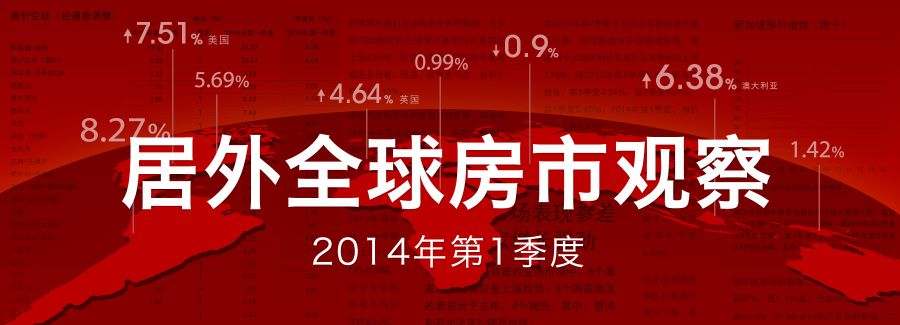Asia News
- Home
- News
- Asia News
You've successfully copied this link.
Juwai Q1 Global Property Index Report

Lastest Juwai report published for Chinese consumers' in their overseas property search.
The Juwai Global Property Index (GPI) Report in China is developed as a resource, with comprehensive analysis of global property markets, for Chinese buyers in their international property hunt.
This is one of many pieces of editorial and research that Juwai's Chinese consumer team produces for our exclusive audience of 1.5 monthly high net worth Chinese buyers visiting the site for information on overseas property.
To date, property markets in most countries have reverted back to pre-crisis levels, and housing prices are rising worldwide. With many housing markets now considered overvalued, several countries have implemented cooling measures to regulate housing markets – Asia in particular.
In return, investors have swarmed to the Pacific, the Gulf, and some to Europe, leading to robust growth and increase in prices.
If you'd like to view the Chinese report directly, download the full report here.
Pacific and Gulf show booming and impressive growth
-
Dubai's spectacular run – property demand is surging and the economy remains strong with a 31.57% YoY annual housing price increase.
-
New Zealand's 8.36% rise in median house pricing – this follows YoY 8.02% Q4 increase and 6.4% Q3 increase.
-
Australian house prices continue its rapid rise, thanks to record low interest rates and strong demand from offshore investors – housing prices in 8 major cities increased by 8.3%, its strongest performance since Q2 2010.
North America home markets remained resilient with modest growth
-
US home prices dropped slightly QoQ by 0.5% in Q1 2014, but rose 5.41% in the year to Q1 2014. Almost all 20 major US cities experienced a growth phenomenon.
-
US cities with the most growth included Las Vegas (+19.25%), its highest rise in history, San Francisco (+19.05%), San Diego (+17.06%), Los Angeles (+15.05%), and Miami (+14.36%).
-
Canadian prices rose 2.98% – despite cooling measures implemented by the government.
European markets experiencing strong growth
-
Ireland and UK residential home prices rose by 7.49% and 7.35% respectively – a sharp contrast to the 3.49% YoY decline for Ireland and 2.52% for UK a year before.
-
Baltic prices soared – housing prices in Tallinn, Estonia surged 20.04%, while prices increased by 4.83% and 4.55% respectively in Vilnius, Lithuania and Riga, Latvia.
-
Iceland enjoyed a strong 7.37% growth in housing prices – up from its meagre annual growth of 0.59% last year.
European markets with decline or weak growth
-
Greece charted a decline of -7.08% – its smallest decline since Q3 2011.
-
Spain housing prices fell -5.41% – an improvement from last year's annual decline of 12.82%.
Booming Asian housing markets with exceptional performances
-
Taiwan house prices soared by 11.28% – a slight improvement from last year's 10.17% increase.
-
Philippines savoured a massive price hike – average price of 3-bedroom condominiums in Makati CBD surged 8.95%, a sharp improvement from its 2.32% annual growth last year.
-
Some Asian markets with moderate growth were Malaysia (+4.35%), Thailand (+3.64%), and Tokyo, Japan (+3.32%).
Other falling property markets
-
Hong Kong homes fell -2.27% – government cooling measures led to the sharp fall from its annual growth of 20.44% last year. However, market curbs have been eased just days before, greatly boosting the housing market.
-
Singapore market continues to decrease – prices dropped -1.68%, resulting from government cooling measures implemented in the past year.
-
South Africa's real estate market, although still weak, saw 0.89% increase – an improvement from the annual declines of 1.34% in Q4 2013.
- Israel's housing market slowed – average price of owner-occupied dwellings increased 1.85%, a drop from 8.21% growth last year.
Conclusion: The global house price boom has not only retained its momentum, but is accelerating its pace and trending upwards strongly. Of 45 housing markets, 30 showed stronger upward momentum, while the remaining 15 portrayed weaker momentum.
Liked this article? Sign up for free to get Juwai Juwai Asia Market updates!
Sort By
- 2023
- 2022
- 2021
- 2020
- 2019
- 2018
- 2017
- 2016
- 2015
- 2014
- 2013
- 2012
Tags
- australia
- china
- chinese buyers
- investment
- juwai
- property
- real estate
- residential
- united kingdom
- united states
Resources
Our Property Marketplaces
Juwai.com >
Global property portal available in Chinese
Juwai.asia >
Asia wide portal for global real estate
Juwai News
Subscribe to receive the latest news on Asian buyers, the Asia market, and Juwai.
Thank you for subscribing to Juwai News!
Sign up for a Juwai Account now for free to enjoy FREE download access to country-specific reports on Chinese property investments.
Do you want to sign up now? Or continue if you have already signed up or you will do it later.
Thank you!
You’ve just subscribed to get updates
to the Chinese Buyer Tips blog by email.
2025 © Juwai. All Rights Reserved Privacy Policy | Terms of Service


